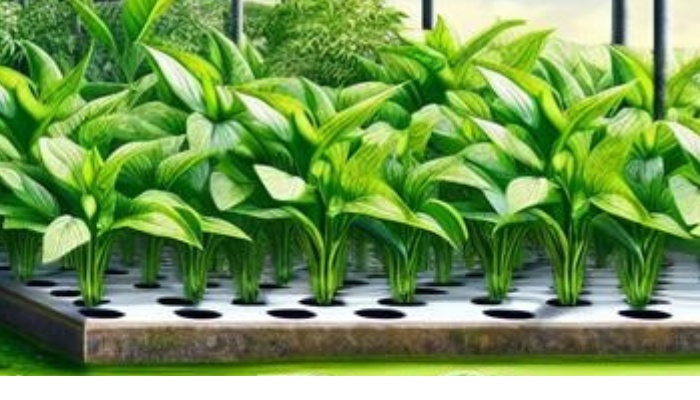Algae’s impact on your plants’ health and your system’s efficiency can be profound, ranging from clogged filters to deprived nutrients.
Preventing and solving these issues requires a keen understanding of algae’s behavior and the conditions that fuel its growth.
As we explore effective strategies for algae control, you’ll discover not only how to reclaim your garden from this green invader but also how to prevent future outbreaks, ensuring your hydroponic system remains productive and healthy.
Understanding Algae Growth
Understanding how environmental conditions like light, nutrients, and water temperature foster algae growth is beneficial for effectively managing algae in hydroponic systems.
Different algae types, including green algae, blue-green algae (cyanobacteria), and diatoms, thrive under specific conditions. Their growth is primarily driven by the process of photosynthesis, which requires light.
Algae use light energy to convert carbon dioxide and water into sugars and oxygen, a process that’s significantly impacted by the availability of nutrients such as nitrogen and phosphorus in the water.
Excess nutrients in your hydroponic system, coupled with ample light and favorable water temperatures (usually between 65 and 85°F), create an ideal environment for algae proliferation.
The impact of photosynthesis on algae growth is double-edged. While it aids in their growth by producing essential sugars, it also increases the oxygen content in the water, which can influence the types of algae that dominate.
Understanding these dynamics is critical in anticipating and managing algae growth effectively.
Effects on Hydroponic Systems
Algae proliferation in hydroponic systems can significantly disrupt plant growth by competing for essential nutrients and blocking light penetration.
This competition is detrimental as it directly impacts the resources available to your plants, potentially stunting their development.
Furthermore, certain algae can produce substances harmful to plant roots, exacerbating the challenge of maintaining a healthy hydroponic garden.
Beyond nutrient competition, algae growth leads to system clogging. This is particularly problematic in systems with intricate watering mechanisms, such as drip or mist systems.
Algae can clog these systems, leading to uneven water distribution and, consequently, inconsistent plant growth. The efficiency of your system is compromised, requiring more frequent maintenance and potentially costly repairs.
While algae benefits are often touted in natural ecosystems for their role in oxygen production and as a food source for aquatic life, in hydroponics, the cons far outweigh the pros.
The presence of algae in your system is an indicator of imbalance, signaling that conditions are favorable for unwanted growth.
Understanding these effects is essential for maintaining an optimal environment for your hydroponic plants and avoiding the pitfalls of unchecked algae proliferation.
Prevention Strategies
Algae growth can be significantly minimized by focusing on water quality, nutrient management, and system design from the outset. Here’s how you can prevent algae in your hydroponic setup:
Maintain Optimal Water Quality
Ensuring the water used in your hydroponic system is clean and free of algae spores is imperative. Regularly test and adjust the pH and EC (electrical conductivity) levels to optimize conditions for your plants and not for algae.
This includes using filtered water and avoiding the introduction of untreated water that may harbor algae spores.
Strategic Nutrient Management
Overfeeding plants can lead to excessive nutrient concentrations in the water, which fuels algae growth.
Implement precise nutrient management practices, measuring and adjusting nutrient solutions based on plant uptake and evapotranspiration rates. This balance minimizes nutrient wastage and reduces algae’s food source.
Design Systems to Limit Light Exposure
Algae need light to photosynthesize. Design your hydroponic system to minimize light penetration into nutrient solutions.
Use opaque materials for tubing and reservoirs, and cover any exposed surfaces that could allow light to enter and promote algae growth.
Solutions for Algae Control
Despite meticulous prevention efforts, you may still encounter algae in your hydroponic system. To mitigate its impact and preserve plant health, effective control solutions are required.
Tackling algae growth requires a combination of chemical treatments and introducing biological competitors to regain balance in your system.
Chemical treatments involve using algaecides that are safe for your plants but lethal to algae. It’s crucial to select the right chemical that targets algae without harming your hydroponic flora.
Biological competitors, such as beneficial bacteria and certain types of fungi, naturally compete with algae for nutrients and space, effectively reducing its proliferation.
Physical removal methods such as filtration and UV sterilization can be effective, but they require regular maintenance. Reducing the light availability and carefully controlling the water’s temperature can also be beneficial.
Some growers have the best results when they implement a combination of control methods and strive to be more diligent in routine system maintenance.
Monitoring and Maintenance
You’ve taken the first steps to mitigate algae growth, but without consistent oversight, your efforts could be in vain. To maintain an optimal environment for your plants and prevent algae reappearance, consider these recommended practices:
Regular Monitoring of Water Quality
Water quality is paramount in a hydroponic system. Parameters such as pH, nutrient concentration, and dissolved oxygen levels must be frequently checked. Fluctuations can create favorable conditions for algae.
Implementing a routine for testing water quality helps you adjust the nutrient solution promptly and ensure your plants receive the ideal balance for growth without promoting algae.
System Automation for Precision
Incorporating system automation can significantly enhance your ability to maintain stable conditions within your hydroponic setup.
Automated systems can adjust lighting, temperature, and nutrient dosing with precision, reducing the chances of human error that might lead to algae outbreaks.
Cleaning and Sanitization Schedule
Regularly cleaning your system and replacing water prevents the accumulation of organic matter, which algae thrive on.
Establish a cleaning schedule that includes sanitizing grow trays, reservoirs, and system components to minimize algae-friendly environments.

